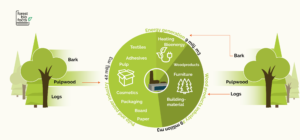Wood can be turned into a variety of products
Do you start your morning by enjoying a cup of latte? Did you notice that the milk carton you opened was possibly made completely from a wood-based material, including its bioplastic coating? Every day, we run into different wood-based products more often than we think. Many food products are sold in wood-based packaging, we use tissues every day and even coffee would be more difficult to make if there were no filter bags. What is more, wood-based cellulose is used in many food, cosmetic and medicinal products as different fillers and additives, such as in ice cream, ketchup, medicines and toothpaste.
What are all the uses of wood-based cellulose? Watch the video!
All parts of a tree have their uses
Wood is used to make many different bioproducts. Different parts of a tree are used for purposes that produce the highest added value. Logs are mainly made from of (lower parts of) large-diameter stems and, in turn, these are used to make wood products, such as timber and plywood for construction. Thinner trees and tree tops are used as pulpwood, which is used to make pulp, paper, board and other bioproducts. Bark and branches are used to generate renewable energy 1.
The majority of wood (34,8 million cubic metres) are used in the pulp and paper industry. The wood products industry consumes 26,3 million cubic metres, of which 8,5million cubic metres of sawmill chips and dust generated as by-products are used in the pulp and paper industry 1.

Different parts of the tree will be utilised as logs, pulpwood and energy and correspondingly to multiple different products.1
Watch what Niklas von Weymarn, CEO of Metsä Spring, has to say about the effective use of wood and side streams!
Packaging material from wood fibres
The most important task of packaging is to protect the product inside the packaging and also the environment from the product. It makes it easier to handle the product in the supply chain and by consumers, and it says something about the product. Wood-based packaging is a bio-based and recyclable option for packaging food products and consumables.
Through online sales, the importance of packaging is increasing. Corrugated cardboard is a superior solution in terms of its durability and lightness. It can also be used in the cold chain to replace polystyrene foam (e.g. styrofoam). Different fibre-based interior packing materials have also been developed to replace polystyrene foam in packaging 2. Wood can also be used to make bioplastics that can be used in coatings of liquid packages made from board and in moulded packaging solutions for ready meals. In the initial production is also a biomaterial-based packaging material made of wood fibres, that can be converted for example into shopping bags 3. Smart packaging to which RFID or NFC tags are attached, can be used in the management of global supply chains to help, to identify and track individual products and even to interact directly with consumers.
Watch what Antti Matula, senior vice president at Kemira, has to say about the role chemistry plays in replacing disposable plastics with renewable materials!
More wood-based solutions
Wood-plastic composites in wooden casts, kitchen utensils, speakers, (future) car parts and building material reduce the ecological footprint and offer a strong material. Cellulose acetate can, for example, be used in LCD screens of mobile phones, eyeglass temples and handles of tools, such as screwdrivers. Wood construction and the use of wood in interior design are constantly growing fields, as people have a demand for natural, healthy and modern spaces and atmospheres. Wood is an energy-efficient building material, and it sequesters carbon in long-life products. The most common engineered wooden products are cross-laminated timber (CLT), glue-laminated timber (GLT) and laminated veneer lumber (LVL).

Wood-based products can contribute positively to the environment 4, 5, 6.
New bioproducts are constantly under development
In addition to conventional wood-based products, wood can also be used as raw material for new bioproducts. The consumption of and need for textiles will increase, and we need to find more sustainable options for cotton and fossil-based synthetic fibres. While wood-based textiles, such as rayon and Tencel, have a long history, with rayon even dating back more than a hundred years, there is still demand for significantly more environmentally friendly textile manufacturing technologies7,8. Currently, manufacturing technologies that consume less energy and fewer chemicals are being developed. For example, pulp can be processed mechanically to produce very small microfibrillated cellulose, which can be used to make fibres directly without any solvents. In another textile technology under development, pulp is first dissolved in an ionic fluid, after which it is pressed to form thin strands that can be used to make yarn 9
. In yet another technology, fibres are first separated, after which the material is made liquid and then the liquid is converted into textile fibres 10. In addition to wood-based cellulose, some waste products from agriculture, such as straws, and cellulose obtained from recycled textile fibres can be used as raw material in these textile technologies 11
Wood-based biochemicals are also developed widely. For example, raw tall oil, turpentine and xylose can be used in the chemical, plastic and construction industries 12. Tall oil is further processed to make distillates that are used in paints and varnishes in the chemical industry and in cosmetic products, such as perfumes. Wooden ingredients and wood-based material are also used in wound dressings and as base material in medicines.
Renewable wood-based transport fuels offer an alternative for fossil fuels. Tall oil, produced as a by-product of chemical pulping, is used to make renewable wood-based diesel. Carbon dioxide emissions can be reduced by nearly 80 % compared with fossil fuels, as the energy source is bio-based and generated in pulping process, apart from hydrogen made from natural gas during hydrogen processing 15. Tall oil can also be used to make second-generation bioethanol to replace fossil petrol.
Lignin accounts for up to 30 % of biomass in all plants, including trees. In addition to bioenergy and biofuels, it is used in different industrial applications, such as resins, adhesives, bioplastics and polyurethane.13,14
Nanocellulose comprises nano-sized fibrils that have unique properties as a result of their size. Its dimensions are measured in nanometres, usually being less than 100 nm. Because of its small size, the strength and surface properties of nanocellulose can be used in various applications, such as to lighten board and composites, to reinforce packaging material and to adjust rheology in cosmetics, food, paints and coatings 16.
How wood is processed into fibre-based materials?
Wood consists of cellulose, lignin and hemicellulose. All of these have a different chemical composition and also a different structural function in wood cells. Wood is processed in different ways, depending on the end product and desired properties. Next, you can read more about chemical wood processing and products, starting from pulping. We should not, however, forget wood products industry processes, in which wood is processed mechanically by sawing and planning, for example, to produce e.g. building material.
Production starts by pulping
Wood can be processed in different ways using mechanical, chemical or thermal methods. Logs are first debarked. Mechanical pulp is produced by grinding wood against a grinding stone or by breaking chips using sheet grinders. The yield of mechanical pulp is nearly 100 %, meaning that practically nothing is wasted. The downside is that mechanical pulping consumes large amount of energy, and the strength properties of pulp are poor 17.
In chemical pulping, wood chips are treated chemically so that bonds between fibres weaken until fibres can be separated from one another without any heavy mechanical treatment. The yield is lower, as approximately half of wood dissolves during cooking (lignin and in the production of textile cellulose also hemicellulose is lost)17.
The chemical pulping process of a kraft pulp mill, consists of three integrated phases:
- A fibre line where wood components are separated.
- A recovery boiler where cooking chemicals are recovered, and the dissolved lignin is burned to generate steam and electricity at the mill.
- Chemical regeneration where cooking chemicals are reactivated. Lignin, extractives and resin are possibly recovered as by-products.
In addition to the kraft pulping, different sulphite cooking processes can also be used 20.
Modern pulp mills generate more energy than they consume. Energy is generated when black liquor is burned in a recovery boiler. Paper mill integrated with pulp mill can easily use this excess energy. The use of by-products and side streams reduces the need for external energy and chemicals at pulp mills. Currently, we are referring to bioproduct mills and biorefineries rather than pulp mills 21.
A modern pulp mill produces not only various by-products, but also more energy than it needs. Watch more!
Mechanical pulp also has its place
For certain purposes, such as the processing of the fluting between the linerboards of corrugated cardboard, chemical pulp is a too high-quality and expensive material, whereas mechanical pulp does not meet the quality requirements. The solution is chemi-mechanical pulp, which is produced by combining the effects of chemical and mechanical treatments on fibres 17.
Mechanical pulp is used in newspapers, uncoated papers and lightly coated magazine papers. It is also used in different boards and tissues 18. Fibres may not be as long and strong as in chemical pulp, while mechanical pulp have a better opacity, and they therefore offer good optical properties for magazines, for example. 19
Pulp is dried in paper production
The idea behind paper and board production is fairly simple: First, pulp is mixed with water and spread evenly over the paper machine web. Then, water is removed by means of pressure and heat. A modern paper machine is a highly sophisticated and technical system. For example, the world’s fastest paper machines produce paper at a speed of 300 m2 per second, 24/7. Paper is approximately 0.1 mm thick, and its quality must be even so that printing machines can produce high-quality material.
Paper and board can be coated in accordance with the requirements set for end products. Target of coating is to smoothen the surface structure of paper to improve the appearance and quality of paper and the printability. However, 50–80 % of the properties of coated paper depend on the properties of the base paper. Coatings consist of pigments, such as kaolin or calcium carbonate. They also contain binders and additives22
Food products often require a packaging with water-, air- and/or greaseproof barrier layers. As a result, board is coated with oil- or bio-based (such as tall oil- or sugar cane-based) plastics or dispersions.
Fibres are recycled seven times
Recycled fibres are used in tissues, packaging and newspapers, among others. Printing ink is removed from recycled fibres. Fibres can be recycled at maximum seven times 23, 24. Only 7 % of fibre-based raw material used in Finland’s paper and board industry consists of recycled fibres. As Finland exports more than 95 % of all paper produced here, in practice, all recycled fibres available are used in Finland, and the recovery rate of paper waste from households is roughly 94 %. Primary fibre is a natural raw material in Finland, as we have abundant forest resources and a small population. In Europe, recycled fibres account for some 50 % of raw materials 24. Primary fibres are needed, at least in part, in products that must be strong or possess certain optical properties. Primary fibres can also be safely used in packaging, in which fibres are in direct contact with food products.
Wood fibre-based textiles will be needed in the future. Watch more to see why!
Wood construction will change our ways of building. Watch more!
